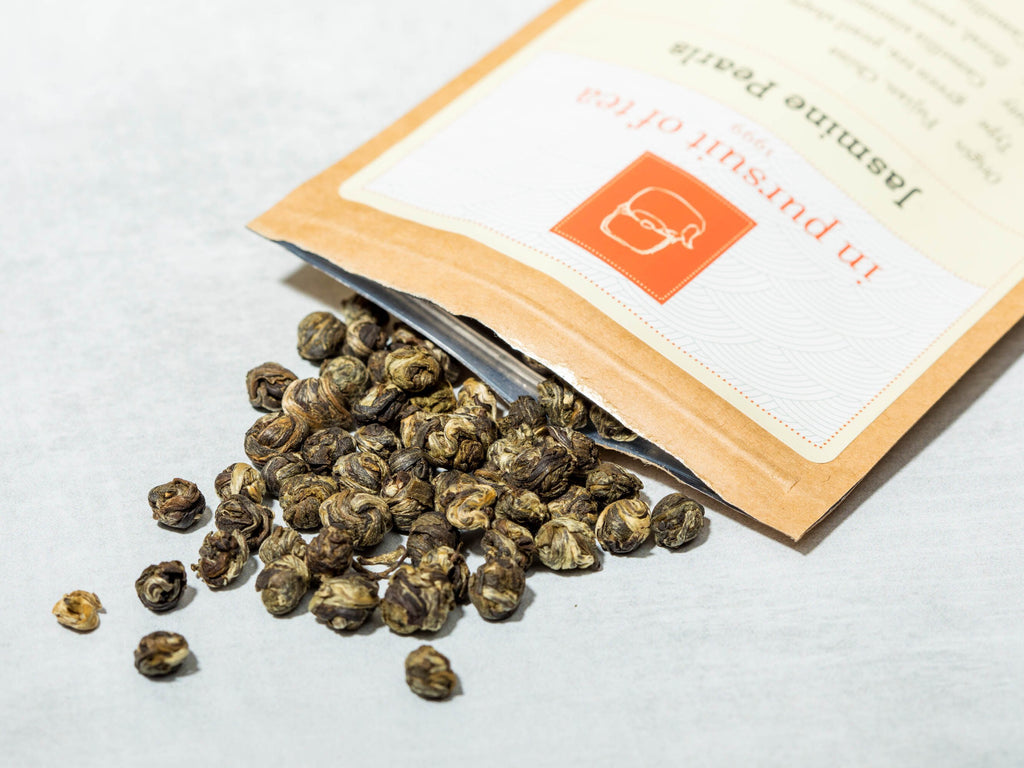Gems of the Tea World: All About Jasmine Pearls

For many tea drinkers, Jasmine Pearls are a first love. They are a marvel—not just of traditional tea crafts, but of engineering, aesthetics and olfactory skill. And brewing Jasmine Pearls is an event: the spheres bob in water like roiling bubbles, then gracefully unfurl into individual tea leaf and bud sets as a floral fragrance fills the room.
It's no wonder that this tea has been one of our bestsellers for nearly 20 years.
Jasmine flowers are among some of the oldest ingredients added to traditional Chinese tea. So what is this tea exactly, and how is it made? Like many subjects in tea, the answer is more intricate than you may expect.
First, some tea terminology
Some teas are blended with ingredients like flower blossoms or petals to add visual appeal when those added elements brew along with the tea leaves. Others are flavored quickly with aromatic oils—like our Earl Grey, which is a black tea mixed with bergamot oil. Many jasmine teas are also made this way, relying on natural or synthesized jasmine aroma; to our taste, these productions can be harsh and unbalanced, like walking into a dense cloud of perfume. Our Jasmine Pearls are scented only with fresh jasmine flowers, a process that's much more involved, but we think well worth it.

Traditional scenting is a painstaking process of layering tea leaves with fragrant ingredients until it's suffused with pleasing aromas, then removing the ingredient. Tea is a natural odor absorber; that's why it's important to store your tea away from strong smells like in your kitchen. It's also why heaping jasmine blossoms atop green tea allows the leaves to be gradually imbued with the flowers' natural fragrance. This method—which takes longer and is more costly than using scented oils—yields an aroma that truly bonds with the inherent flavor of the tea.
Pearls of tea
Before a green tea can be scented with jasmine flowers, it must be picked and shaped. Our Jasmine Pearls are made from spring harvest leaves from Fujian Province. Many lower-end jasmine teas are made with lower grade or more abundant summer harvests. This material can make a decent green tea, but its coarser flavor and thinner texture don't pair as well with delicate jasmine flowers.
The best leaves for jasmine teas are grown at high altitude, says our friend Jason Chen, the owner of CC Fine Tea and one of the trusted partners we've worked with to secure quality pearls over the years. "High-altitude teas taste sweeter," he explains, "with more body, and the taste lingers longer." Compared to teas cultivated at sea level, teas at high elevation grow slower in the cooler temperatures, concentrating their nutrients and flavor.

Once the young leaves are picked, they're individually hand-rolled into tight pearls and dried in an oven with circulating hot air. Most tea destined for jasmine scenting is processed as green tea, though sometimes you'll see other types like black or oolong.
A mountain of flowers
China's capital of jasmine production is near Fujian, in Guangxi Province. When the jasmine plants produce flower buds in July, the dried tea pearls are transported to a facility for scenting. It's an amazing sight, the flower markets; unopened jasmine blossoms look like white pearls with green tails, and you'll find them heaped in sacks for sale.
Jasmine flowers bloom at night; this is when they release most of their fragrance. So for several nights, tea workers carefully intermingle the dried green tea pearls with jasmine blossoms. "If you listen at night you can hear the pop pop of the flowers opening," Chen says. On the first night, 100 pounds of tea will be scented with 200 pounds of jasmine flowers; the next scenting night, 100 pounds of jasmine flowers will be used, then 50 the following, and so on, to more fully fix the fragrance. Naturally scented jasmine pearls are priced according to how many nights of processing they receive; lower budget versions may just be scented once or twice, while higher value lots could be scented up to seven times. And keep in mind, this scenting process may not happen over consecutive evenings; depending on the weather and quality of the jasmine harvest, a producer may need to wait up to a month to finish the process.

During each night's scenting period, workers turn over the pile every few hours to evenly distribute the flowers. The next morning, the mix is run through a sorting machine to remove the spent jasmine blossoms and let the tea dry off for the day. Resellers pick up the leftover blossoms, which they may add to lower grades of tea as an ornamental blend, or use in cosmetics or traditional medicine. With such a labor-intensive product, nothing goes to waste.
How to brew Jasmine Pearls
Considering their visual appeal, try brewing jasmine pearls so you can watch them unfurl: Place a large pinch in a wine glass and cover with hot water, or use a glass pot. We use water around 180°F and steep for two to three minutes, so as not to overbrew the delicate green tea base. You can re-steep jasmine pearls two or three times to get the most of the intensive floral scenting; subsequent steeps will reveal more of the nutty green tea. Jasmine also takes marvelously to cold and ambient brewing for iced tea.
However you prepare your looseleaf Jasmine Pearls—or teabags, or large-format Jasmine Flower Craft—the key to appreciation is taking your time to enjoy each step of the way. This tea requires months of careful cultivation, processing, storage, and scenting from skilled hands across two provinces. There's a reason they're called pearls.
On-location photos courtesy of Jason Chen.
